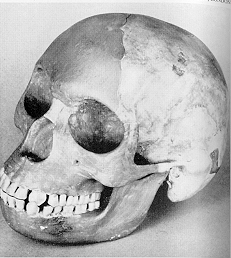 Piltdown
Man
Piltdown
Man Piltdown
Man
Piltdown
Man
Search for the Missing Link
In 1856 the first Neanderthal fossil was discovered, in 1859 Charles Darwin published The Origin of Species. A Europe wide search for the missing link between ape and man continued throughout the second half of the 19th century. Britain was largely ignored until in 1912 Charles Dawson found pieces of a skull in a quarry in Piltdown; it was thought to be that of an ancient Pleistocene hominid. In the following years between 1912 and 1915 another skull was found and an elephant molar and canine tooth were also discovered. Piltdown man had a large cranial space, a simian jaw but humanoid teeth. These features along with the other fossils indicating the time of deposit and the discovery of a tool made from a fossil elephant thigh suggesting intelligence confirmed the discovery.
The Unmasking of a Hoax
In1953 Piltdown man was revealed as a hoax by Wiener, Le Gros Clark and Oakley. By this time Piltdown man had been largely ignored and marginalized as more discoveries were made and the remains fitted in less and less with the developing theory. With the advent of a new dating technique - the Fluorine Absorption Test, the ageing of the finds was proposed. In 1949 the tests revealed that the skulls were actually only 620 years old and mediaeval. The jawbone was found to be that of an orangutan and approximately 500 years old. The other finds were genuine.
The Fluorine Absorption Test
Teeth and bones will absorb fluorine from their environment, when this happens the fluorine reacts with phosphate hydroxy-apatite (the main component of teeth and bones) to form fluorapatite. The amount of fluorine present in the fossils should match if they were deposited at the same time. Although the test could not give an absolute date the results were very surprising indeed. The cranial fragments had a much greater fluorine content than that of the jaw and therefore could not be from the same person. A nitrogen content test was also carried out as nitrogen content decreases with age and could give a relative idea of age. A wide variety of results found some of the pieces were much younger than others. Radiocarbon dating put a final date on the skulls, confirming that they were mediaeval in origin.
Science Fooled?
Why was the hoax so successful?
A number of factors contributed;